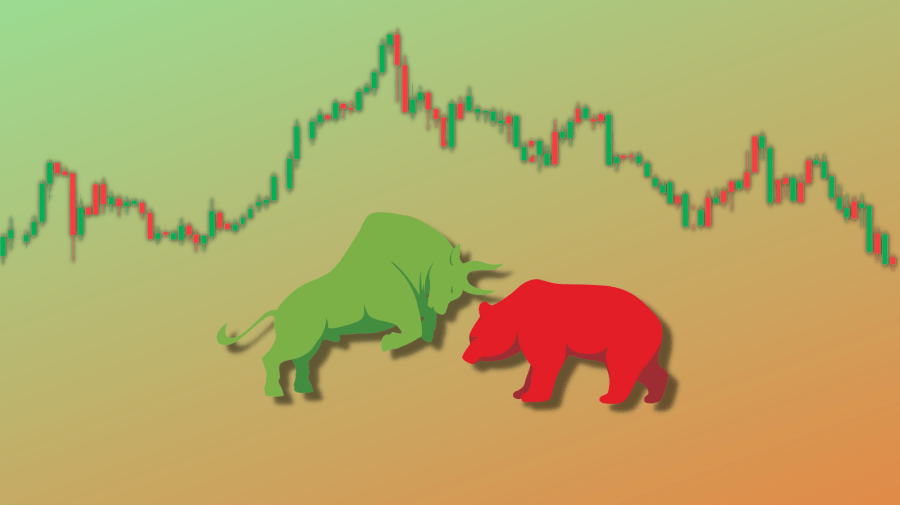
With inflation running rampant and an ongoing sense of economic uncertainty, the United States’ stock market is taking a real beating. Broadly, stock values are tumbling, leading to a lot of chatter about a “bear market”. Even if you’re new to investing or the world of financial markets, you’ve likely heard the term — and the phrase “bull market” — before. But what’s this financial jargon mean? If you want to learn more about the terms, our current financial situation and how the stock market’s trajectory may impact your portfolio, read on to learn more about the bull vs bear market.
What Is a Bull Market?
Generally speaking, bull markets are viewed as a positive for investors. During a bull market, stock prices are on a clear upward trajectory. While there isn’t a formal definition in regards to what qualifies as a bull market, most experts agree that prices need to rise at least 20 percent for at least two months in a broad market index — like the S&P 500 — for the situation to qualify as a bull market. However, others feel that an upward trend that’s more generally sustained can mark a bull market, even if it doesn’t reach the 20 percent threshold.
It’s also important to note that market segments or individual stocks can be “bullish”. For example, if tech companies are seeing prices rise quickly and significantly, even if the rest of the market is relatively stable or declining, the tech segment is a bull market. Similarly, investment experts may be bullish on a particular stock, indicating that they feel an upward trend is going to remain.

What Is a Bear Market?
In the simplest sense, a bear market is the opposite of a bull market; in a bear market, stock prices drop significantly. For some experts, bear markets are defined by a key index showing at least a 20 percent decline over two or more months. However, others feel that a general tumbling can indicate a bearish turn.
Like with bullish conditions, individual sectors or stocks can also be bearish. With sectors, a bear market marks a decline in stock values in that particular arena, often in counter to stock price activity in other sectors. For individual stocks, experts may feel bearish if they believe a downward price trend is going to continue.
How Bull vs. Bear Markets Differ
Bull vs bear markets — the two markets are opposite sides of the same coin. They’re reflective of broader economic conditions as well as the public sentiment about the state of the consumer market, wage levels and more. On average, bull markets tend to be longer-lasting and, generally, the cumulative gains of bull markets often outweigh the losses in bear markets. That’s why, even with past recessions and depressions, the stock market value trends upward in a broad sense.
Bull vs. Bear: Why the Market Types Matter
In many cases, bull and bear markets aren’t just measures of the condition of the stock market; they’re reflective of the broader economy. With a bull market, there’s typically economic prosperity on a wider level. Investors and consumers often share a sense of optimism, leading to higher spending and economic expansion.
With a bear market, on the other hand, there are usually economic challenges. Inflation, recessions and the like may arise, along with the declining stock values. Consumer sentiment is typically also cautious, if not outright fearful, thus altering spending patterns. Finally, economic contraction can occur, and wages usually stall or decline.
Where Experts Think We Are Now
Currently, experts say the U.S. is in a bear market — at least based on the S&P 500. On June 13, 2022, the benchmark S&P 500 closed 21.8 percent below its January 3, 2022 record closing. Since that’s more than 20 percent from its peak, most experts consider it a bear market.
This kind of decline has left many Americans concerned. On average, it takes a bit more than one year for the market to hit bottom during a bear market. Then, it traditionally takes another two years to reach that past high. However, the longest bear market recovery took more than five years. On the other hand, the bear market in 2020 — triggered by the COVID-19 pandemic — lasted just 33 days. That’s a significant amount of variance.
It’s also important to note that bear markets are a normal part of the economic cycle, with one usually happening about every four years. Additionally, they aren’t universally followed by recessions, though that can certainly occur.

In 2022, financial experts are debating whether a recession is, in fact, on the horizon. While the U.S. Federal Reserve has taken action in an attempt to wrangle inflation, it may take time for any price corrections to take hold. Since a recession is simply defined as two sequential quarters with a substantial decline in economic activity, many feel one is inevitable at this point. However, precisely how one will take shape isn’t clear.
How Investors Should Navigate Market Downturns
While the current bear market situation may be concerning, you shouldn’t act rashly. Instead, it’s critical to avoid panic selling or other dramatic changes to your portfolio. In most cases, if you’re a long-term investor, you have little to fear during bear markets. Typically, recoveries do happen, and you can capture additional gains over time. Since that’s the case, a calm, metered and well-researched approach is best if you want to weather downward trends smartly.
What you may not know? A bear market can actually present an opportunity, too. Certain stocks may be priced far below their typical value — and not because the company itself is at risk of a substantial downturn or failure. By investing regularly — that is, every week or every month — and diversifying your investments, you can easily reduce risk and, potentially, capture some benefits thanks to those bargain-priced stocks.
If you’re a shorter-term investor, caution is also a must during a bear market. Research will be your ally; not all stocks experience the same price shifts during bear markets, after all. Depending on your financial goals, you may want to shift your funds to something more stable if you need to tap into them sooner rather than later. But whether or not that shift is best depends on your unique situation. As always, speaking with a financial advisor before making any big moves is the best course of action.






